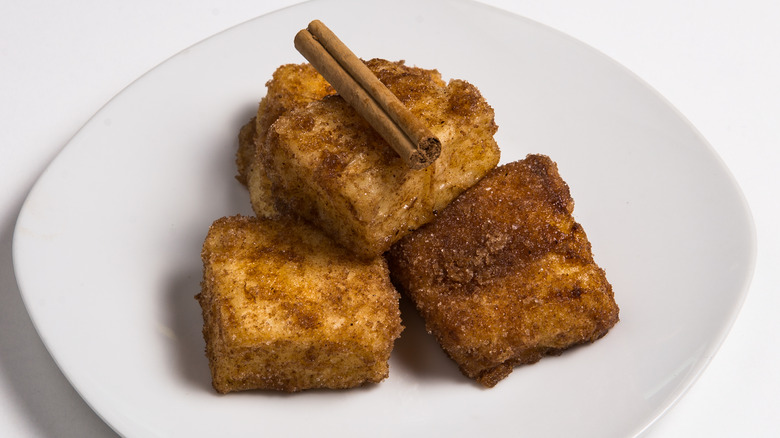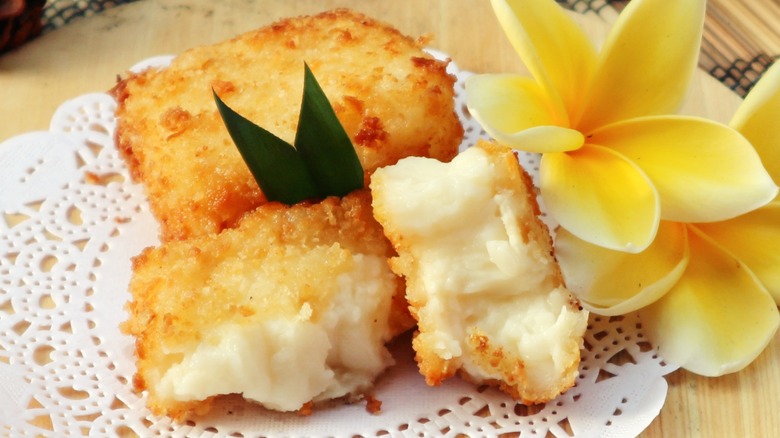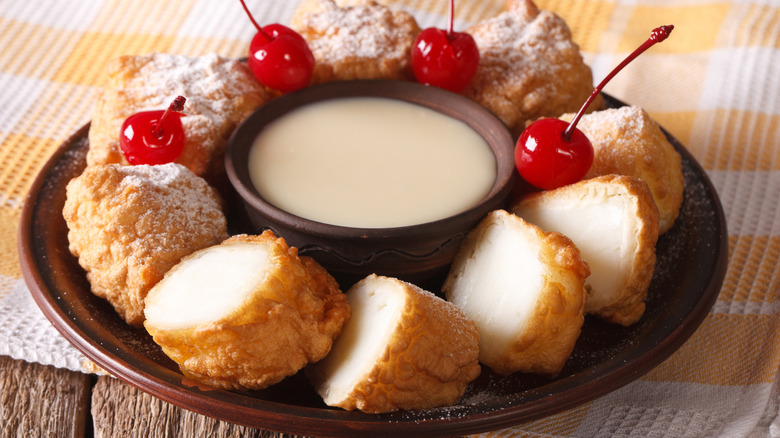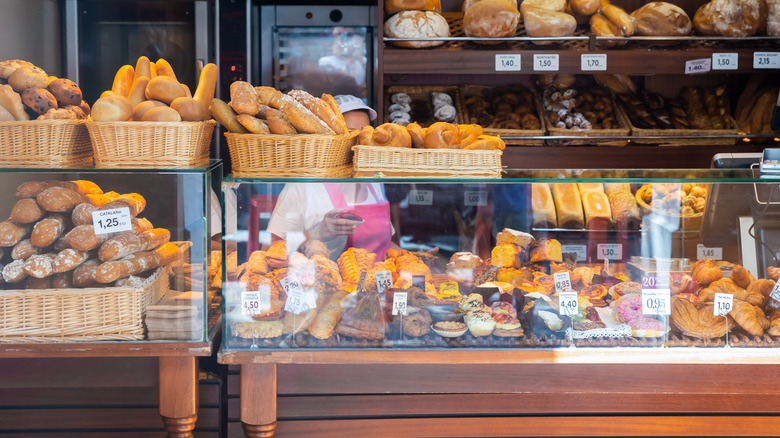Leche Frita: The Spanish Fried Milk Dessert With Few Ingredients
Whether food traditions are shared or invented independently, similarities between recipes pop up all over the world, and fried milk is one that stretches from Eastern Asia all the way to Western Europe. In China, fried milk is a popular street snack that comes in both savory and sweet forms. In the Ligurian region of Italy, latte dolce fritto (sweet fried milk) is regularly enjoyed as the dessert course of the fritto misto, or fried seafood mix.
However, it's in Spain where this springy little dessert came into its own. Called leche frita, these deep-fried custard fritters dusted with a coat of sugar and cinnamon are beloved, utterly delicious (milk pun intended), and are just as much at home as street food as they are served up on a gleaming piece of porcelain. Leche frita is so popular in Spain that its origin is often disputed between regions; it seems all of Spain wants a piece of the leche frita story. But dessert lovers beyond Spain have fallen in love with these simple treats, which are, if you've got the patience, one of the easiest you can make.
Disputed origins of leche frita
Like so many other food items throughout history, the exact origins of these fried pudding cubes (which is a bit more accurate than "milk") are unknown. One theory is that the dessert originated with the conquering Arabs; another claims that leche fritas were whipped up and sold by Catholic nuns to fund the operation of the convents. What is certainly true is that several Spanish regions, such as Palencia, Valladolid, Castile, Léon, and Basque Country, all claim to have originated the traditional dessert.
So while we can't say for sure exactly who in Spain decided this dessert was a good idea, we can at least thank them for inventing it. We can also be grateful to the nuns and the countless Spaniards who spread the news of this dessert across the country, thereby making it available for people across Spain and, indeed, the world to enjoy.
A few simple ingredients
The beautiful thing about this treat is how simple it is. Leche frita begins with cornstarch, milk, and sugar, which are mixed and left to thicken for about twenty minutes. During this time, additional milk is gently heated on the stove and flavored with a cinnamon stick, until it froths, at which point it's poured into the cornstarch mixture. The new mixture then gets returned to the stove to be heated and stirred until it thickens into a pudding.
At this stage, the pudding needs to be chilled for a minimum of four hours or overnight. Chilling the mixture in a square or rectangular dish will help shape the pudding and make it easier to divide it into cubes later on. The longer the pudding chills, the easier it will be to handle during the final stage.
Once the pudding is chilled and cubed, it's coated first with flour and then with egg. Sit the leche on a wire rack above a paper towel to catch any excess coating. The egg and flour provide a nice crust, and protect the pudding from the heat of the cooking oil. Leche frita can be deep fried, which is traditional, or pan-fried in butter. Either way, the results are the same: crispy, golden brown, and springy. Dust them with a cinnamon sugar mix, and they're ready to eat.
Serving options
There are several ways to serve leche frita, each as delicious as the next. As they are, warm yet firm, with a crisp exterior and a soft, sweet interior, leche frita are perfect on their own. A few cubes could be paired with a frothy Spanish Cortado, a nice espresso, or even a sweet dessert wine, like Málaga, should you feel inclined.
If you want to get decadent, try serving up leche frita straight from the frier alongside vanilla ice cream. The effect of the melting ice cream over the leche frita is the same as when it melts over a brownie sundae. Only this is fried milk instead of chocolate. The heat emitting off the leche will melt the ice cream and beautifully coat the cubes. The chill of the ice cream will also balance the heat from the fresh leche.
Leche frita can be served at room temperature or cold outside the fridge. The crispiness will give way to a more bouncy, Turkish Delight style consistency, but the flavors remain. Cold leche frita is an excellent accompaniment to an iced coffee on a warm spring day. However you like your leche frita, the sweet flavors work well with various pairings.
Where to find leche frita
The easiest way for folks in the U.S. to sample leche frita is to either travel to Spain or make them at home. This is not to say that certain specialty grocery stores, bakeries, restaurants, or cafés won't serve leche frita. Just don't count on it as being a regular dessert item anywhere but in authentic Spanish restaurants. Still, as the ingredients for this sweet treat are readily available at any grocery store, making leche frita at home is probably the easiest (certainly, the cheapest) way to experience them for yourself.
If you're booking a trip to Spain, don't miss out on these treats and, if possible, plan your trip around certain holidays. Easter, Carnival, and Lent are all times of the year when leche frita will be at its most abundant, but, you're likely to find some in whatever season you decide to travel if you look hard enough.
Though the rough translation of "fried milk" will sound odd to some, leche frita is one of the more delicious and simple sweets you can make or eat. With the right amount of patience and a little know-how, you can satisfy your sweet tooth and those of your guests, with this simple, wonderful Spanish delight.




